Information
LHCb-DP-2012-005
arXiv:1302.5259 [PDF]
(Submitted on 21 Feb 2013)
JINST 8 P08002
Inspire 1220569
Tools
Abstract
The LHCb Vertex Locator (VELO) is a silicon strip detector designed to reconstruct charged particle trajectories and vertices produced at the LHCb interaction region. During the first two years of data collection, the 84 VELO sensors have been exposed to a range of fluences up to a maximum value of approximately $\rm{45 \times 10^{12} 1 MeV}$ neutron equivalent ($\rm{1 MeV n_{eq}}$). At the operational sensor temperature of approximately $-7 ^{\circ}\rm{C}$, the average rate of sensor current increase is $18 \upmu\rm{A}$ per $\rm{fb^{-1}}$, in excellent agreement with predictions. The silicon effective bandgap has been determined using current versus temperature scan data after irradiation, with an average value of $E_{g}=1.16\pm0.03\pm0.04 \rm{eV}$ obtained. The first observation of n-on-n sensor type inversion at the LHC has been made, occurring at a fluence of around $15 \times 10 ^{12}$ of $1 \rm{MeV n_{eq}}$. The only n-on-p sensors in use at the LHC have also been studied. With an initial fluence of approximately $\rm{3 \times 10^{12} 1 MeV n_{eq}}$, a decrease in the Effective Depletion Voltage (EDV) of around 25 V is observed, attributed to oxygen induced removal of boron interstitial sites. Following this initial decrease, the EDV increases at a comparable rate to the type inverted n-on-n type sensors, with rates of $(1.43\pm 0.16) \times 10 ^{-12} \rm{V} / 1 \rm{MeV n_{eq}}$ and $(1.35\pm 0.25) \times 10 ^{-12} \rm{V} / 1 \rm{MeV n_{eq}}$ measured for n-on-p and n-on-n type sensors, respectively. A reduction in the charge collection efficiency due to an unexpected effect involving the second metal layer readout lines is observed.
Figures and captions
|
A schematic representation of an R-type and a $\rm{\phi}$-type sensor, with the routing lines orientated perpendicular and parallel to the silicon strips, respectively. |
fig1.pdf [165 KiB] HiDef png [3 MiB] Thumbnail [1 MiB] |

|
|
Currents measured in the VELO for each sensor as a function of time (bottom). The luminosity delivered to LHCb and the average sensor temperature is shown over the same time scale (middle and top). Increases in the delivered luminosity are matched by increases in the sensor currents. The mean measured current agrees well with the prediction from simulation, which is described in Sect.2.4. The mean measured value excludes sensors that are surface-current dominated. |
fig2.pdf [74 KiB] HiDef png [635 KiB] Thumbnail [301 KiB] |

|
|
The current versus temperature for two VELO sensors operated at the nominal $150\rm{ V}$ bias. Before irradiation there is a small exponential component for the sensor shown in figure a), while that shown in figure b) is dominated by the non-temperature dependent surface current contribution. After irradiation, a large exponential component is seen for both sensors. These sensors are now bulk current dominated and the surface current has largely been annealed. |
fig3a.pdf [97 KiB] HiDef png [668 KiB] Thumbnail [229 KiB] |

|
|
fig3b.pdf [90 KiB] HiDef png [619 KiB] Thumbnail [219 KiB] |

|
|
|
a) The fluence from $\rm{1 fb^{-1}}$ of integrated luminosity versus radius for two VELO sensors, as seen in simulated proton-proton collisions at a $7$ TeV centre-of-mass energy. Top b) In each sensor, the fluence as a function of radius is fitted with the function $\rm{Ar^{k}}$. The fitted exponent, ${\rm k}$, is shown as a function of the sensor $z$-coordinate, where $z$ is the distance along the beam-axis that a sensor is from the interaction region. The distribution of the fluence across the sensor is seen to become flatter with increasing distance from the interaction region. Bottom b) The fluence at the innermost radius of the sensor against the sensor $z$-coordinate. |
fig4a.pdf [59 KiB] HiDef png [742 KiB] Thumbnail [273 KiB] |
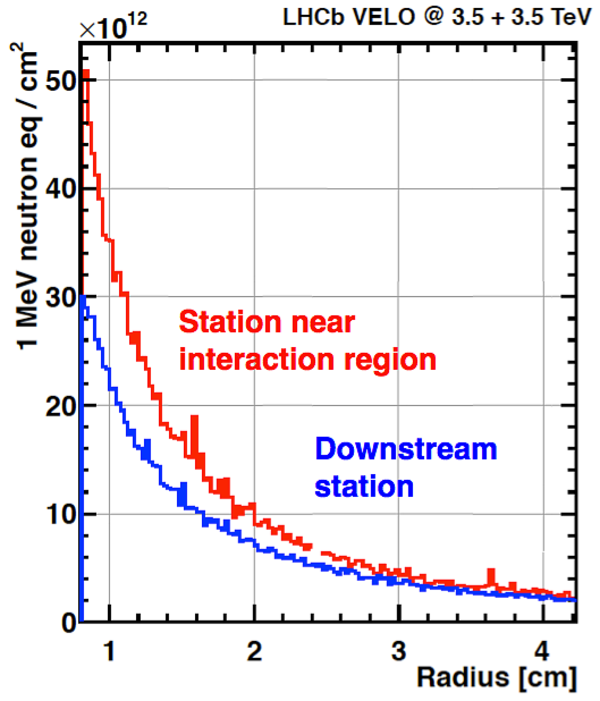
|
|
fig4b.pdf [47 KiB] HiDef png [848 KiB] Thumbnail [392 KiB] |
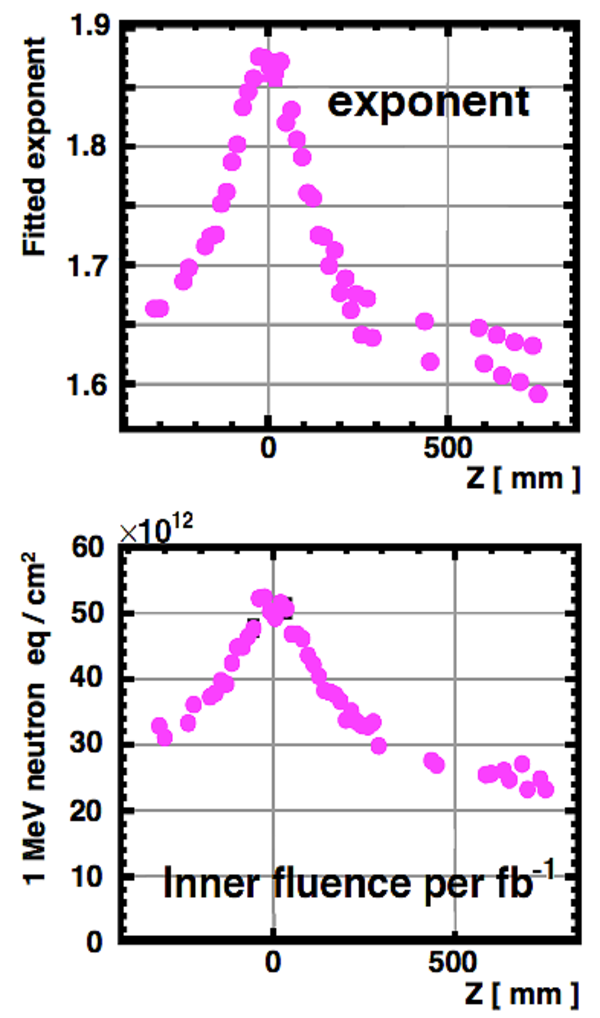
|
|
|
The leakage current against sensor $z$-coordinate after $\rm{1.20 fb^{-1}}$ of integrated luminosity, normalised to $0 ^{\circ}{\rm C}$. The data is in agreement with predictions, represented by the shaded region. The two VELO halves are referred to as the A and C sides of the VELO. |
fig5.pdf [63 KiB] HiDef png [328 KiB] Thumbnail [199 KiB] |
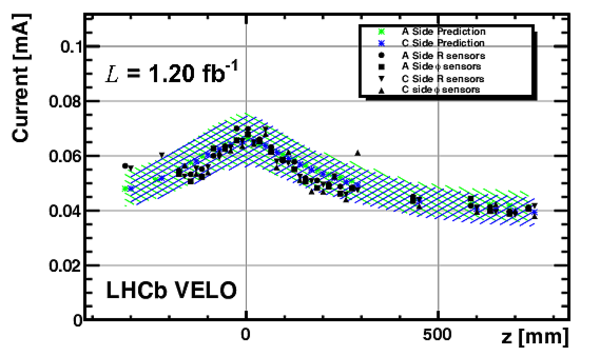
|
|
a) The pedestal subtracted ADC distributions for an R-type sensor at three example bias voltages. b) The MPV of the fit to the ADC distribution vs. bias voltage. The dashed lines represent the ADC that is $80\%$ of the plateau value, and the corresponding EDV. |
fig6a.pdf [23 KiB] HiDef png [317 KiB] Thumbnail [278 KiB] |
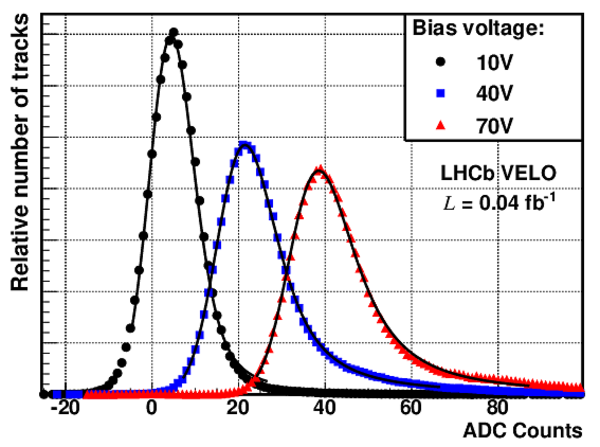
|
|
fig6b.pdf [14 KiB] HiDef png [310 KiB] Thumbnail [284 KiB] |
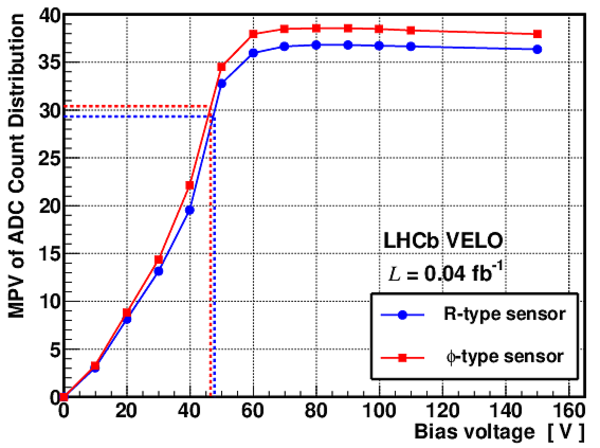
|
|
|
a) The EDV against sensor radius for an $\rm {\it{n^+}} -on -{\it{n}}$ {} type sensor for each of the CCE scans. The dashed line shows the mean EDV across all radius regions prior to sensor irradiation, where some $0 \rm{fb^{-1}}$ data points are not present due to low statistics. b) A similar plot for the $\rm {\it{n^+}} -on -{\it{p}}$ {}, $\phi$-type sensor. The minimum EDV is $\rm{\mathord{\sim} 40 V}$, which is significantly higher than the minimum at $\rm{\mathord{\sim} 20 V}$ observed for the $\rm {\it{n^+}} -on -{\it{n}}$ {} type sensor. |
fig7a.pdf [15 KiB] HiDef png [187 KiB] Thumbnail [190 KiB] |

|
|
fig7b.pdf [14 KiB] HiDef png [177 KiB] Thumbnail [183 KiB] |

|
|
|
The EDV against fluence for VELO sensors of various initial EDV. The EDV from data is compared to depletion voltages predicted by the Hamburg model, with good agreement observed prior to, and after sensor type-inversion. |
fig8.pdf [60 KiB] HiDef png [458 KiB] Thumbnail [305 KiB] |

|
|
The inverse of the sensor noise against bias voltage for a particular $\rm {\it{n^+}} -on -{\it{n}}$ {} and $\rm {\it{n^+}} -on -{\it{p}}$ {} type sensor, for two values of integrated luminosities. The C-V scan measured initial depletion voltages are shown by the dashed lines. |
fig9.pdf [17 KiB] HiDef png [250 KiB] Thumbnail [222 KiB] |

|
|
The CFE for an R-type $\rm {\it{n^+}} -on -{\it{n}}$ {} sensor as a function of sensor radius for a) different amounts of delivered luminosity and b) several different bias voltages. |
fig10a.pdf [15 KiB] HiDef png [202 KiB] Thumbnail [185 KiB] |

|
|
fig10b.pdf [15 KiB] HiDef png [221 KiB] Thumbnail [193 KiB] |

|
|
|
a) The layout of the second metal layer routing lines on an R-type sensor. The darker regions represent the presence of routing lines, and the lighter regions their absence. b) The CFE shown in small spatial regions of an R-type sensor. |
fig11a.pdf [466 KiB] HiDef png [2 MiB] Thumbnail [674 KiB] |

|
|
fig11b.pdf [577 KiB] HiDef png [2 MiB] Thumbnail [598 KiB] |

|
|
|
A photograph of the innermost region of an R-type sensor. Strips run from the bottom-left to the top-right. Each strip is connected to a routing line orientated perpendicularly to the strip. |
fig12.pdf [1 MiB] HiDef png [7 MiB] Thumbnail [1 MiB] |
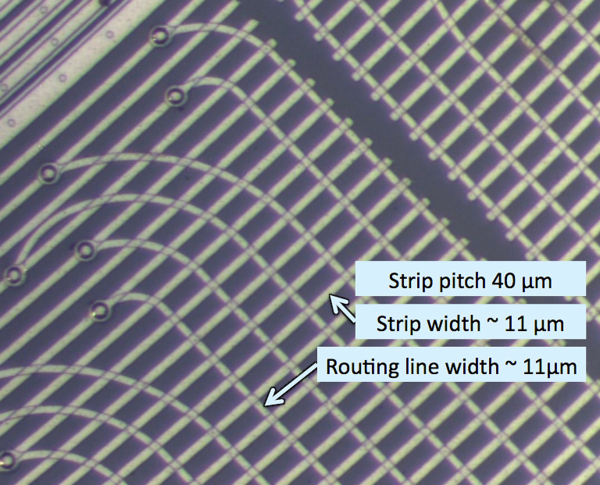
|
|
A schematic cross-section of a portion of an R-type sensor, showing the relative position of the two metal layers used to carry the readout signals in $\rm {\it{n^+}} -on -{\it{n}}$ {} type sensors. The $n^{+}$ implants and strips (into the page) run perpendicularly to the routing lines (left to right). For clarity the routing line of just one strip is shown. |
fig13.pdf [33 KiB] HiDef png [169 KiB] Thumbnail [60 KiB] |

|
|
The CFE as a function of the distance between the particle intercept and the nearest routing line, for several bins of the distance between the particle intercept and closest strip edge. |
fig14.pdf [16 KiB] HiDef png [305 KiB] Thumbnail [293 KiB] |

|
|
For R-type sensors: a) The ADC spectrum of all clusters seen for three different integrated luminosities. The limit at $10$ ADC counts is imposed by the clustering thresholds. b) The fraction of reconstructed clusters that are induced on routing lines as a function of the distance to the nearest routing line and strip. This is determined from the number of track intercepts for which the inner strip associated to the nearest routing line has a $1$ strip cluster with less than $35$ ADC counts. |
fig15a.pdf [16 KiB] HiDef png [210 KiB] Thumbnail [199 KiB] |
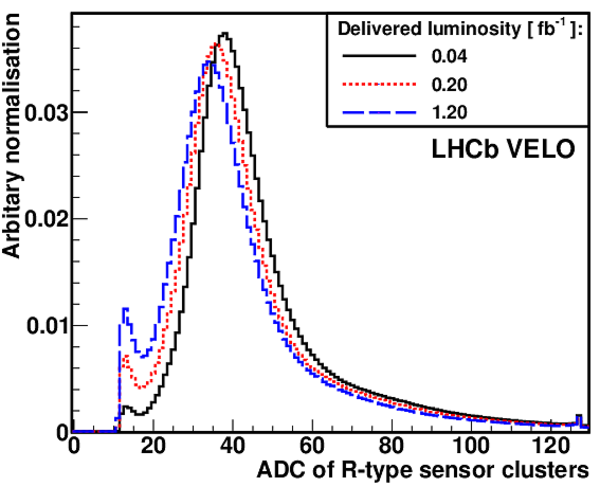
|
|
fig15b.pdf [18 KiB] HiDef png [289 KiB] Thumbnail [260 KiB] |

|
|
|
a) The CFE as a function of the distance between the particle intercept and the nearest routing line and strip edge, compared for an $\rm {\it{n^+}} -on -{\it{n}}$ {} and $\rm {\it{n^+}} -on -{\it{p}}$ {} sensor. b) The MPV vs. bias voltage for an $\rm {\it{n^+}} -on -{\it{n}}$ {} and $\rm {\it{n^+}} -on -{\it{p}}$ {} sensor. |
fig16a.pdf [16 KiB] HiDef png [263 KiB] Thumbnail [258 KiB] |

|
|
fig16b.pdf [14 KiB] HiDef png [334 KiB] Thumbnail [271 KiB] |

|
|
|
The MPV against bias voltage for an R-type sensor at three values of delivered luminosity. The sensor region has been identified as having type inverted in the $1.20 \rm{fb^{-1}}$ scan, in which the MPV dependence on voltage is no longer present. |
fig17.pdf [14 KiB] HiDef png [347 KiB] Thumbnail [243 KiB] |

|
|
Animated gif made out of all figures. |
DP-2012-005.gif Thumbnail |

|
Tables and captions
|
The VELO sensor design parameters. The sensor position along the beam axis is given relative to the beam interaction region. |
Table_1.pdf [47 KiB] HiDef png [75 KiB] Thumbnail [34 KiB] tex code |

|
|
The effective band gap, $E_{g}$, measured following various amounts of delivered luminosity. The first uncertainty is statistical and the second is systematic. |
Table_2.pdf [51 KiB] HiDef png [50 KiB] Thumbnail [24 KiB] tex code |

|
Created on 18 October 2023.
